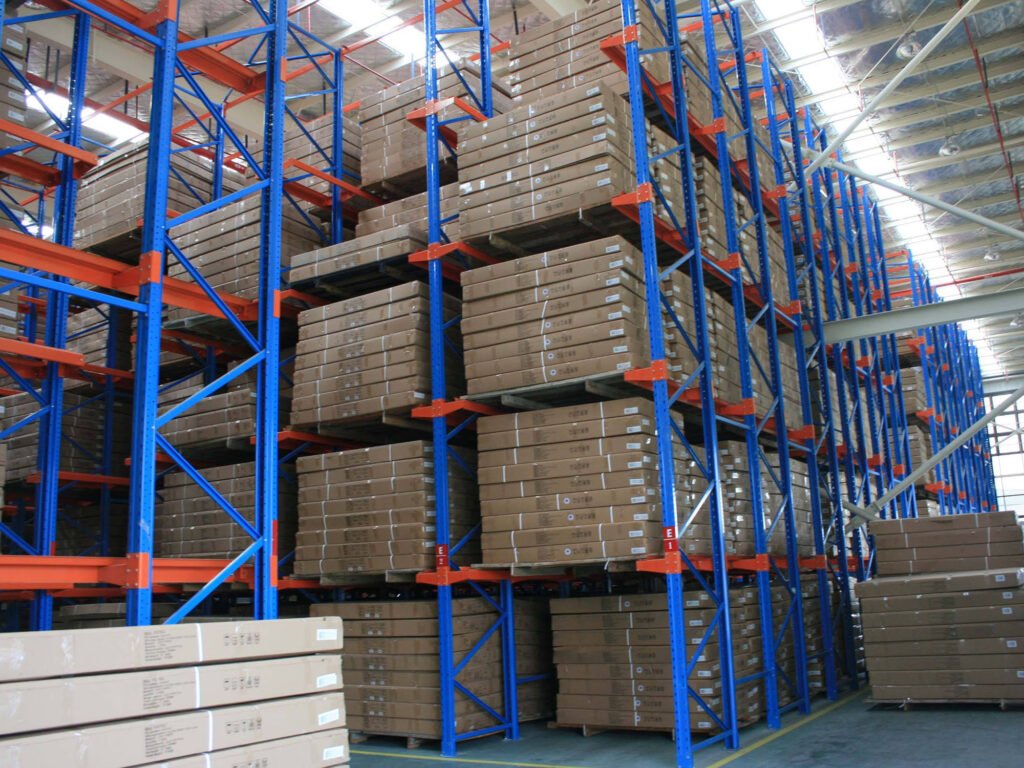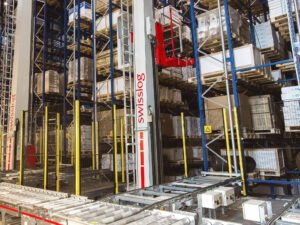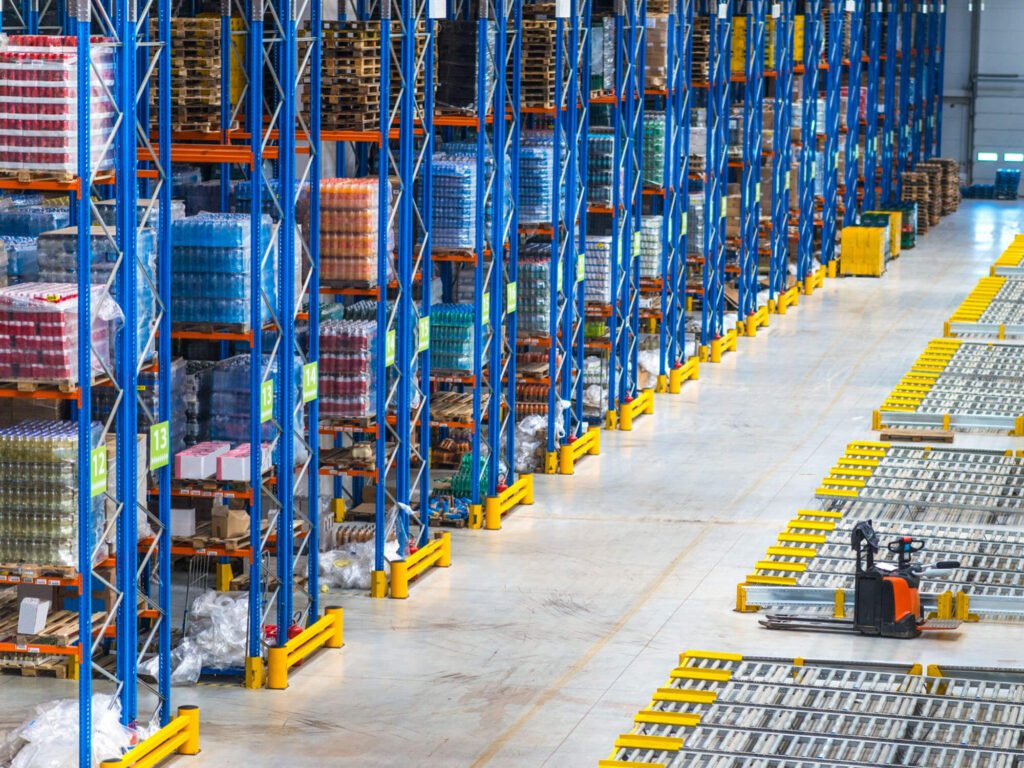Have you ever felt that your warehouse was overflowing with products and running out of space? High-density storage may be the solution to your space-saving demands. It is a storage strategy that focuses on maximizing the amount of products that can be stored in a compact area, which is a big advantage in today’s competitive world when warehouse space is a precious commodity.
Although the primary benefit of high-density storage is undoubtedly its capacity to conserve space, the advantages extend far beyond the mere act of accumulating additional items in your warehouse. Plus, these solutions lead to improved inventory management, reduced operating costs, and increased efficiency.
This detailed guide will walk you through everything there is to know about high-density storage, from its categorization to the pros and cons of each type, as well as why you should opt for Chinese manufacturers for these items. You’ll also explore various high-density storage trends that are about to become a reality.
What Is High-Density Storage?
High-density storage is a warehousing strategy that aims to optimize storage capacity in a limited space. In contrast to traditional storage methods, which promote individual access to each pallet, high-density storage systems consolidate products into a smaller area, occasionally eliminating superfluous aisles and increasing vertical space utilization.
The underlying premise of high-density storage is to reduce wasted space. Traditional racking systems sometimes need large aisles for forklifts and other material handling equipment to navigate, resulting in substantial space waste. High-density storage systems solve this problem by using novel racking designs, such as drive-in racks, push-back racks, and mobile racking systems, which minimize aisle width while increasing storage density.
High-density storage is efficient because it can store the same amount of commodities in a smaller area than traditional methods. Warehouses can significantly increase their storage capacity by eliminating unnecessary lanes and increasing vertical space without incurring costly expansions or relocations.
Additionally, high-density storage boosts warehouse efficiency and productivity by shortening worker travel lengths and improving picking routes. Certain high-density storage systems, such as automated storage and retrieval systems (AS/RS), can further enhance efficiency by automating the storage and retrieval processes.
Types Of High-Density Storage Systems: A Complete Guide
Are you ready to clear clutter and recover warehouse space? From modern mobile racking systems to dynamic pallet flow racks, the kinds of high-density storage solutions are as diverse as your inventory requirements. Below are the top six variations for maximizing your warehouse space utilization.
#1: Drive-In Racking
Drive-in racking is a common high-density storage option that removes typical storage aisles to increase space efficiency. It comprises continuous lanes along which forklifts may deposit or retrieve pallets. This method follows the Last-In, First-Out (LIFO) principle, which means that the pallet that was loaded last is the first to be removed.
Pallets are stored in drive-in racking on rails or support arms that reach the whole depth of the rack. Forklifts drive right into the lanes and place or retrieve pallets from the front. This design reduces the need for several access lanes, resulting in much more storage capacity within the same space.
Drive-in racking is appropriate for warehouses that store huge amounts of similar items, such as those with a small number of SKUs (stock-keeping units). It is a low-cost approach for increasing storage density in facilities where selectivity isn’t a major issue.
PROs:
- Cost-effective owing to reduced aisle space and minimal racking components.
- Suitable for bulk storage of similar products.
- Simplifying stock management via the LIFO system.
CONs:
- Having limited selectivity, as only the front pallet can be accessed without rearranging others.
- Requiring specialized forklifts (reach trucks) to operate within the lanes.
#2: Drive-Through Racking
Where on Earth can you have drive-in racking’s amazing space-saving capability without compromising the simple access of selective racking? Welcome to drive-through racking, a high-density storage system that provides a unique balance of efficiency and flexibility.
Drive-through racking, like drive-in racking, has deep channels to provide forklift access. Drive-through racking, unlike drive-in racking, permits access from both ends of the lane. This allows for a First-In, First-Out (FIFO) inventory system, in which the first pallet loaded in the first one retrieved.
Drive-through racking is ideal for operations with high throughput and perishable inventory that requires regular rotation. It ensures that older things are used or dispatched first, which reduces the risk of spoilage or obsolescence.
While drive-through racking is more accessible than drive-in racking, it still needs larger aisles than typical selective racking to allow forklift mobility inside the lanes. However, drive-through racking’s greater storage density and efficient stock management often justify this trade-off.
PROs:
- Facilitating FIFO inventory management, ideal for perishable goods.
- Improved accessibility compared to drive-in racking.
- Efficient for high-volume throughput.
CON:
- Demanding wider aisles than selective racking.
#3: Push-Back Racking
Need to store a variety of things while optimizing warehouse space? Push-back racking is just what you need in such circumstances! This dynamic inventory solution offers a unique mix of high-density storage and individual pallet access, making it a versatile option for warehouses with a diverse inventory need.
Push-back racking consists of a series of stacked carts on sloped rails. When a pallet is put into the rack, it pushes the current pallets back, resulting in a cascade effect. This enables the stacking of numerous containers in a single lane, thereby significantly increasing storage density in comparison to conventional selective racking.
This high-density storage solution is attractive since it allows for more inventory management flexibility. It works well for both FIFO (First-In, First-Out) and LIFO (Last-In, First-Out) inventory rotation, depending on your requirements. This makes it suited for a broad variety of products, from perishable commodities that must be consumed quickly to slower-moving things that may be kept for an extended length of time.
PROs:
- Offering both FIFO and LIFO inventory management options.
- Good selectivity, as each pallet can be accessed individually.
- Efficient for medium to high SKU counts.
CON:
- More expensive than drive-in racking due to the complex cart and rail system.
#4: Pallet Flow Racking
Also referred to as gravity flow racking, pallet flow racking is a high-density storage system that utilizes gravity to enhance inventory management and order fulfillment. It is composed of inclined rails or rollers that facilitate the seamless transition of pallets from the loading end to the picking face, thereby ensuring a consistent and efficient First-In, First-Out (FIFO) inventory rotation.
This system is suited for facilities with high-volume picking operations and perishable inventory. The gravity-fed design lowers the need for forklift intervention, decreasing labor costs and increasing picking speed. Pallets are loaded at the rear and automatically moved forward to the picking face, ensuring that older inventory is gathered first and lowering the risk of spoilage or obsolescence.
This high-efficiency storage system may also significantly boost warehouse productivity and throughput. However, adequate installation and maintenance are necessary to ensure smooth operation and minimize pallet jams or damage.
PROs:
- Providing excellent FIFO inventory rotation.
- Increasing picking speed and efficiency.
- Reducing labor costs.
CON:
- Needing a higher initial investment and complex installation compared to other high-density storage systems.
#5: Mobile Racking Systems
Did you know that the distinctive mobile racking system offers an extraordinary 80% to 120% more storage capacity than conventional pallet racking?
How do they do this? Mobile racking systems are made up of rows of pallet racks set on mobile bases that roll along floor tracks. When you need to access a certain aisle, the system acts as a magical gateway, producing a temporary lane for your forklift to enter. When not in use, the racks compress together to save aisle space and increase storage density.
This dynamic system is perfect for warehouses with limited floor space or those that must adapt to fluctuating inventory levels. With mobile racking, you can quickly change your warehouse layout, adding aisles as required. This adaptability not only increases space use but also allows for excellent inventory management and speedier picking operations.
Mobile racking systems may be operated manually or electronically, depending on your warehouse’s weight capacity and operating needs. Manual systems are often controlled using a hand crank or push-pull mechanism, while electronic systems use motors and control panels to automate movement.
Regardless of the operating mode, mobile racking systems have safety elements to safeguard both items and personnel. Some of these vital features include:
- Inner and external barriers: These physical obstacles are precisely positioned to detect any items or people in the path of the rolling racks. When detected, they activate an automatic stop mechanism, avoiding accidents and ensuring the safety of both people and stored items.
- Emergency stop buttons and proximity sensors: Think of these features to be the safety brakes on your mobile racking system. The sensors are constantly scanning for anything that may cause a collision, and if they detect something, they instantly hit the brakes, halting the rack in its tracks and averting any damage or injuries.
- Rail stops: Installed at the ends of the tracks, these objects are physical obstacles that prevent movable bases from overshooting and derailing, thus ensuring that the system remains within its permitted operational area.
- Cross-bracing sets: These diagonal or horizontal supports enhance the structural integrity and stability of the mobile racking system. They prevent the racks from swaying or tumbling over, even when fully loaded with heavy merchandise.
- Chain guards: These protective coverings hide the mobile base’s chains and other moving components from harm caused by debris or unintentional contact. This provides smooth functioning and reduces the possibility of mechanical failure.
Overall, mobile racking systems provide a versatile and practical way to increase storage capacity in warehouses with limited space. Their flexibility to shifting needs, along with improved safety measures, make them a good investment for businesses wishing to optimize their warehouse operations.
PROs:
- Providing direct access to each pallet, in contrast to other high-density systems.
- Offering top-notch adaptability to stock fluctuations and warehouse layout modifications.
- Suitable for various product types and sizes.
- Having safety features that protect both products and workers.
CONs:
- Taking longer to access items as the solution needs to be opened and closed.
- Requiring more maintenance efforts due to the various moving parts and electrical components in the systems.
#6: Automated Storage And Retrieval Systems (AS/RS)
No longer is the idea of a warehouse that could run itself a sci-fi one! Automated Storage and Retrieval Systems (AS/RS) are the closest thing to it, which employ automated cranes or shuttles to store and retrieve products from specific places on a high-density storage grid. By doing so, the system eliminates the necessity for manual labor in the storage and retrieval processes, thereby significantly reducing the risk of human error and enhancing the overall accuracy.
AS/RS thrives in contexts where huge amounts of commodities must be kept and retrieved quickly, such as manufacturing, distribution, and e-commerce fulfillment centers. By automating these processes, AS/RS systems can significantly improve throughput, reduce labor costs, and enhance overall warehouse efficiency.
AS/RS also give you accurate and timely product retrieval by integrating with Warehouse Management Systems (WMS), so ensuring optimal storage locations, real-time inventory monitoring, and efficient order fulfillment. This guarantees valuable data insights for inventory management and demand forecasting as well.
PROs:
- Extremely efficient in high-volume operations.
- Augmenting accuracy and reducing errors.
- Enhancing warehouse safety.
CON:
- Involving time-consuming setup processes and a high upfront investment.
Exploring Top Trends In High-Density Storage
Now that you have a good understanding of the many high-density storage options available, let’s look at the developing trends that will influence the future of warehouse storage. These trends are driving innovation and testing the limits of efficiency, sustainability, and technological integration.
Utilizing Vertical Space
One of the most important advances in high-density storage has been the growing utilization of vertical space in warehouses. Businesses may maximize storage capacity by growing upward rather than outward, minimizing the need for costly expansions or more warehouse space. Taller racking systems, mezzanines, and automated vertical lifts all assist to achieve this aim.
Taller racking systems may store items at higher heights, while mezzanines provide more floor space for storage or other functions. Automated vertical lifts, on the other hand, provide efficient and automated access to items kept at high altitudes, decreasing the need for human labor and retrieval times.
Using Warehouse Management Systems (WMS)
Warehouse Management Systems (WMS) act as the digital backbone, organizing efficient operations and providing useful information. WMS technologies provide real-time inventory monitoring, optimum storage location assignments, and quicker picking and replenishment operations, all of which contribute to increased space utilization and productivity.
Contemporary warehouses find cloud-based WMS systems to be highly beneficial due to their ability to provide real-time visibility, flexibility, and scalability across multiple locations. WMS can enhance warehouse operations by automating repetitive procedures, forecasting demand fluctuations, and identifying patterns, thereby reducing personnel costs and errors.
Opting For Flexibility And Scalability
The evolution of e-commerce and the changing demands of customers require storage systems that are adaptable to the changing inventory levels and product categories. High-density storage systems, especially those with modular designs and flexible racking solutions, provide the flexibility required to satisfy these changing demands.
Modular storage solutions enable simple reconfiguration and extension as your warehouse’s needs change. They can be easily customized, such as by adjusting racking heights or beam levels, to fit your individual requirements, whether you need to accommodate new product lines, change storage density, or respond to seasonal inventory swings.
Prioritizing Sustainability
Going green is becoming an important concern in warehouse design and operations. High-density storage solutions may help with this shift by maximizing space usage and reducing the need for warehouse expansions, which can have serious environmental impacts in terms of land use and building materials.
Furthermore, certain high-density storage systems, such as AS/RS, include energy-saving features like regenerative braking and optimized power consumption. This reduces the warehouse’s total energy usage and carbon footprint, leading to a greener and more sustainable operation.
The use of recyclable materials in the building of racking systems and implementing waste reduction measures further improve the long-term viability of high-density storage solutions.
Aiming For Ultra-High-Density Storage Solutions
Even though regular high-density storage systems, like drive-in or push-back racks, make good use of space, the need for even more efficiency led to the creation of ultra-high-density storage solutions. Today’s innovative solutions use cutting-edge technology to increase storage space and change the way warehouses work.
Ultra-high-density systems enhance storage capacity by keeping items in vertically stacked containers or bins inside a grid-like framework, reducing wasted aisle space. These systems often include robotic retrieval techniques, which eliminate the need for human picking and improve space usage.
In comparison to conventional flat storage, these systems have the potential to increase inventory capacity by doubling, tripling, or even quadrupling while maintaining the same dimension. Additionally, they enable “goods-to-person” picking, which involves robotics delivering the required items directly to the operator, thereby dramatically reducing the time required for the journey and improving the efficacy of the picking process.
Ultra-high-density storage solutions offer the ability to improve energy efficiency while reducing space. Some systems utilize energy-efficient robots that use less power, resulting in a greener, more sustainable warehouse operation. Warehouses that adopt ultra-high-density storage systems may see increased efficiency, productivity, and cost-effectiveness.
Why Should You Consider Chinese Manufacturers?
If you’re searching for the best deals on high-density storage solutions without sacrificing quality, look no further than China! In recent years, the country has emerged as a major participant in the global industrial environment, providing a diverse variety of high-density storage solutions at competitive costs.
Here are five major advantages of purchasing high-density storage systems from Chinese manufacturers:
- Cost-effectiveness: Due to reduced labor costs and economies of scale, Chinese manufacturers often provide competitive pricing, enabling organizations to purchase high-quality storage solutions for a fraction of the cost of other nations.
- Wide range of options: China’s large manufacturing sector generates an extensive array of automated storage and retrieval systems, as well as pallet racking and shelving systems.
- Customization capabilities: Chinese manufacturers are renowned for their adaptability and willingness to accommodate customized designs and specifications, ensuring that the storage solution suits the precise needs of your warehouse.
- Quick turnaround times: Thanks to efficient manufacturing processes and streamlined supply networks, Chinese manufacturers can often produce bespoke racking solutions quicker than their counterparts in other nations.
- Production expertise: Many Chinese manufacturers have vast experience developing high-density storage systems that meet international quality requirements and provide experienced help throughout the design and installation processes.
When evaluating high-density storage solutions, it’s important to look into the advantages that Chinese manufacturers, such as Lracking, can provide. Lracking’s affordable price, customization possibilities, and dedication to quality allow them to deliver a personalized storage solution that suits your individual demands and budget.
Conclusion
To summarize, high-density storage is an important approach for warehouses looking to maximize space utilization, improve efficiency, and lower operating costs. These systems provide a compelling alternative for firms experiencing space restrictions or wanting to utilize their current footprint by reducing needless aisle space and increasing vertical storage.
Ultra-high-density systems, robotic automation, and smart technology integration are some of the new trends that are set to make high-density storage even more efficient and flexible in the future. High-density storage will probably play a big role in making the modern transport setting as warehouses get bigger to meet the needs of a market that changes quickly.
If your warehouse is dealing with limited space or inefficient storage techniques, it’s time to look into high-density storage options. By using these creative solutions, you may turn your warehouse into a more efficient, productive, and cost-effective business. Don’t allow space constraints to hold you back; take action now to maximize the possibilities of your warehouse with high-density storage.




